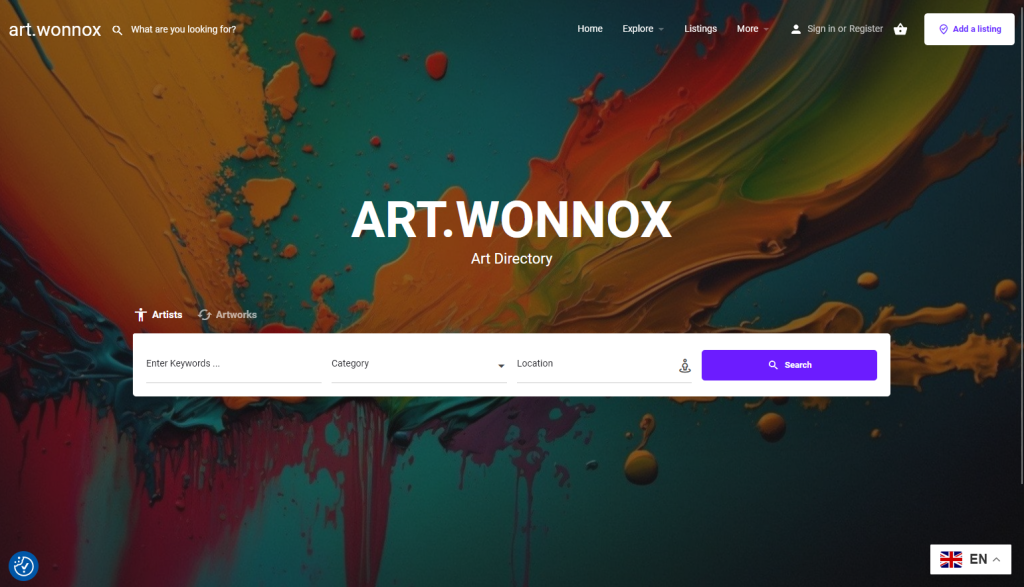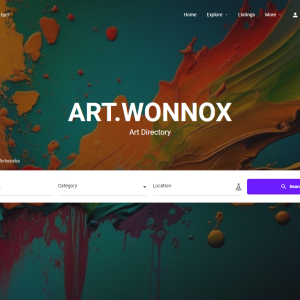
- Direct message
- Leave a review
- Bookmark
- Share
- Report
- prev
- next
Description
An artist listing or profile in a web directory under the "art" category serves as a vital showcase of an artist's creative work, style, and background. It helps connect the artist with potential clients, galleries, art collectors, and fans, providing a platform for greater visibility. A well-crafted artist profile should offer comprehensive insights into the artist’s work, style, inspirations, and professional achievements. Here are the key features of a detailed and engaging artist listing or profile in a web directory:
1. Artist Overview:
Name of the Artist: Clearly display the artist's full name or their preferred artist name. This ensures accurate identification and recognition.
Tagline or Artist Statement: A short tagline or artist statement can capture the essence of the artist’s style or philosophy, such as “Exploring the fusion of nature and urban landscapes” or “Capturing emotions through abstract forms.”
Artistic Style/Medium: Describe the artist’s primary style (e.g., surrealism, abstract, realism) and the medium they specialize in, such as “oil painting,” “digital art,” or “ceramic sculpture.” This helps viewers understand the nature of the artist's work.
Years of Experience: Mention how long the artist has been practicing professionally. For example, “Over 15 years of experience in watercolor painting.” This adds credibility and context to the artist's profile.
2. Contact Information:
Studio Address: If the artist has a physical studio or gallery location, listing the address allows potential buyers or visitors to connect in person.
Email Address: An email contact for inquiries about commissions, exhibitions, or collaborations makes it easier for interested parties to reach the artist.
Phone Number: Including a phone number can provide another direct line of communication for more urgent or detailed inquiries.
Website URL: A link to the artist’s website allows visitors to explore their portfolio in more depth and learn more about the artist’s work.
Social Media Links: Including links to social media profiles (Instagram, Twitter, Facebook, TikTok, or YouTube) where the artist shares their latest works and interacts with followers can help grow their online presence.
3. Artist Bio:
Background and Education: Provide a brief biography, including details about the artist’s education (e.g., art school, university, self-taught) and artistic journey. This gives context to their work and creative development.
Inspirations and Influences: A description of what inspires the artist—be it nature, social issues, historical events, or personal experiences—can offer deeper insight into their work.
Creative Philosophy: Elaborate on the artist’s approach to creating art, their goals, and the message or themes they strive to convey through their work.
4. Portfolio and Gallery:
Sample Artworks: Display a gallery of the artist’s works, with high-resolution images of their best pieces. Each image should include details like title, dimensions, medium, and year of creation.
Exhibition History: Include a list of past exhibitions, solo or group shows, and gallery collaborations, with dates and venues. This showcases the artist’s experience and professional engagements.
Upcoming Shows and Events: Information about any upcoming exhibitions, art fairs, or live events allows potential clients and fans to plan visits and support the artist.
Virtual Tours: If available, offer a virtual tour or 360-degree view of the artist's studio or recent exhibitions. This can engage viewers who are unable to visit in person.
5. Commissions and Services:
Commission Availability: State whether the artist is open to commissioned work, and include guidelines or a process overview for commissioning a custom piece.
Pricing and Fees: While not always mandatory, providing a general range for pricing can help filter inquiries from serious buyers. Terms like “starting from $500 for custom portraits” can be helpful.
Art Services: If the artist offers additional services like art classes, workshops, art consulting, or mural painting, this should be highlighted to attract more diverse opportunities.
6. Achievements and Awards:
Art Awards: Listing any awards or recognitions received in the art world can help establish credibility and showcase the artist's skills and reputation.
Residencies and Grants: Mentioning artist residencies, fellowships, or grants that the artist has been part of provides additional prestige.
Press Mentions: Links to articles, interviews, or media coverage about the artist’s work can offer further insights and validation of their success and influence.
7. Client and Collector Testimonials:
Feedback from Buyers: Including testimonials or reviews from art collectors, gallery owners, or clients who have commissioned pieces can add credibility and build trust.
Quotes from Fans: Highlighting positive feedback from followers or art enthusiasts can create a sense of connection and appreciation for the artist’s work.
8. SEO and Keyword Optimization:
Relevant Keywords: Use keywords that describe the artist’s style, medium, and location, such as “contemporary painter in New York” or “abstract sculptor in London.” This enhances search engine visibility and ensures that the listing reaches the right audience.
Tags and Categories: Adding tags like “oil paintings,” “digital illustrations,” “art classes,” or “sculpture commissions” can help the profile appear in targeted searches.
9. Visual and Multimedia Elements:
Profile Picture: A high-quality photo of the artist adds a personal touch and helps humanize the profile.
Introductory Video: A short video where the artist introduces themselves, discusses their creative process, or gives a behind-the-scenes look at their studio can make the listing more engaging.
Artwork Slideshow: An animated or interactive slideshow of the artist’s works can captivate viewers and keep them engaged longer on the page.
10. Artistic Philosophy and Process:
Creative Process Description: A detailed description of how the artist approaches their work, from conceptualization to execution, can be fascinating for potential clients and fans.
Materials and Techniques: Explaining the materials and unique techniques used in the artwork can help clients appreciate the craftsmanship behind each piece.
Sustainability Practices: If the artist uses eco-friendly materials or follows sustainable practices, this can be a significant selling point in today’s environmentally conscious market.
11. Diversity and Inclusion Statement:
Inclusive Art Practices: If the artist actively promotes diversity, equity, and inclusion through their art or business practices, this should be highlighted.
Community Engagement: Mentioning involvement in community projects, charitable art sales, or public art installations can attract clients who value social impact.
12. Call to Action (CTA):
Encouragement to Engage: A strong call to action, like “Browse My Latest Collection,” “Commission a Custom Piece,” or “Contact for Exhibition Opportunities,” encourages viewers to take the next step.
Subscription Option: Offering a sign-up for newsletters or updates can keep potential buyers and fans engaged and informed about new work or events.
Follow on Social Media: Encouraging visitors to follow the artist on social media platforms can help build a larger online audience and foster ongoing engagement.
13. Metrics and Analytics:
Profile Views and Engagement: Some web directories provide metrics like the number of profile views or artwork likes, which can indicate the artist’s popularity or reach.
Favorites or Saves: Allowing visitors to save or favorite the artist’s profile can help the artist track potential leads or interested buyers.
Contact Form Tracking: Information on how many inquiries have been made through the listing can help the artist gauge interest and improve their marketing approach.
14. Accessibility Features:
Alt Text for Images: Ensuring all images of artwork include descriptive alt text can make the profile more accessible to visually impaired users.
Language Options: If the artist works internationally, providing translation options for their profile can reach a broader audience.
15. Art for Sale or Shop Section:
Online Store Link: If the artist sells art directly through an online store, including a link or integration can streamline the purchase process.
Limited Editions and Prints: Information on available limited edition prints or reproductions can attract collectors who may not be able to purchase original works.
A well-crafted artist listing or profile in a web directory should serve as a comprehensive showcase of the artist's identity, creativity, and professional achievements. By providing detailed insights into their style, services, and work philosophy, artists can attract collectors, clients, and fans who resonate with their vision. With engaging visual elements, clear contact details, and a user-friendly structure, the profile can help artists build meaningful connections within the art community and expand their reach.

Add a review